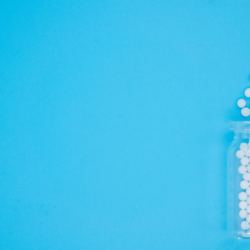Atherosclerosis and arteriosclerosis are common cardiovascular diseases, particularly among the elderly and those with risk factors such as high blood pressure, high cholesterol or a sedentary lifestyle. These pathologies lead to hardening of the arteries, increasing the risk of atheromatous plaque formation and potentially leading to serious complications such as myocardial infarction, stroke and heart failure.
How can atherosclerosis be prevented naturally? In addition to a balanced diet, regular exercise and stress management, homeopathy offers natural solutions for improving blood circulation, reducing inflammation and limiting the progression of cholesterol plaques.
In this article, discover the most effective homeopathic remedies for preventing and slowing down arteriosclerosis and atherosclerosis.
What are the risk factors for atherosclerosis and arteriosclerosis?
Atherosclerosis and arteriosclerosis are often associated in the same patient, increasing the risk of cardiovascular complications. Numerous scientific studies have identified major risk factors influencing the development of atherosclerotic plaques and the stiffness of blood vessels.
- Arterial hypertension, a major risk factor for cardiovascular disease
- Smoking, which promotes inflammation and the accumulation of atherosclerotic plaque
- Obesity, often linked to a diet rich in saturated fats
- Blood lipid imbalance (high LDL cholesterol, excess triglycerides)
- A sedentary lifestyle and lack of physical activity, aggravating circulatory problems
- Chronic stress and an anxious personality type, increasing the risk of hypertension
The role of homeopathy in arteriosclerosis and atherosclerosis
Homeopathy is particularly indicated in the prevention and early stages of atheromatous pathology.
By using local remedies, we aim to :
- Reduce early AHT
- Correct blood sugar and lipid levels
- Reduce obesity
- Reduce the role of stress
On the other hand, a number of drugs have vascular sclerosis phenomena in their pathogenesis; they will also be taken for prevention and in the early stages of arteriosclerosis. When the lesions are more advanced, they may be used only as an adjunct to other treatments.
What homeopathic remedies are available to combat vascular sclerosis?
Each homeopathic remedy has a specific action on vascular health. Some remedies target thickening of the arteries, others promote better management of cholesterol or triglycerides, while still others help to regulate blood pressure and limit oxidative stress. Discover below the main treatments used to slow down the hardening of the arteries and improve blood circulation.
Arsenicum album: a homeopathic remedy to prevent vascular sclerosis
This homeopathic treatment is recommended for people who are thin, cold and tired, suffering from circulatory problems and predisposed to vascular lesions. It is particularly indicated for the prevention of cardiovascular problems linked to arteriosclerosis. So don’t wait to take this medicine until you find the signs of sensitive behaviour that some people are so happy to describe: meticulousness, concern for cleanliness or elegance, etc.
Baryta carbonica :
This medicine is suitable for people who are slow, have memory problems and a certain tendency towards A.T.H., leading to frontal headaches on mental exertion and tinnitus.
Calcarea fluorica :
The patient may present the classic asymmetric constitutional type of this drug, but as always with sensitive typology, its absence is not prohibitive. Arteriosclerosis occurs early, with hardening of the arteries and a tendency to hypertension. There is therefore a context of ligament hyperlaxity, a tendency to bone growths, eczema and varicose ulcers. In this case, we recommend the homeopathic remedy Calcarea fluorica.
Lycopodium :
This is a deep-acting sclerosing remedy. It is particularly indicated in subjects with hepatorenal fragility (urea), and also in cases of lipid metabolism disorders.
Plumbum metallicum :
Plumbum metallicum is a homeopathic remedy used when the arteries are sparse and sclerotic, with a tendency towards arteritis. In addition, there are often signs of renal insufficiency and vascular sclerosis with intellectual repercussions. Elderly patients treated with Plumbum are dry, thin, slow, with a yellowish complexion. There is often associated abdominal pathology.
Silicea :
This homeopathic medicine will be recommended for general signs (thinness, coldness, osteoporosis, tendency to chronic suppurations) concomitant with a tendency to vascular sclerosis.
Baryta iodata :
This homeopathic remedy therefore corresponds to patients prone to cerebral circulatory disorders.
Aurum iodatum :
This homeopathic strain corresponds to those with a hypertensive tendency with cardiac erethism.
Plumbum iodatum :
This medicine is generally used for those suffering from kidney failure.
Arsenicum iodatum :
In practice, this medicine is systematically indicated to prevent arterial sclerosis, whether or not it is associated with myocardial degeneration.
Homeopathy and obesity: how can you protect your arteries?
In overweight or obese patients, the impact on cardiovascular health is significant. Excess weight promotes high blood pressure, increased LDL cholesterol and triglycerides, as well as an increased risk of chronic inflammation, all factors involved in the development of atherosclerosis. Homeopathy can therefore complement dietary management and a more active lifestyle, by targeting both the tendency to gain weight and the underlying metabolic imbalances.
Certain homeopathic remedies are particularly indicated for obese patients, whether due to a family predisposition or an acquired disorder. They help regulate lipid metabolism, improve digestion and limit the cardiovascular repercussions of excess body fat. The main drugs used in this approach are listed below.
Calcarea carbonica :
Obesity often runs in families and/or is constitutional. It may, however, be accompanied by a tendency to diabetes. There may be a background of lithiasis (renal or vesicular) or polyposis (nasal, bladder, etc.).
Sulfur :
Medicine for hyperphagic patients with a psoric reaction mode with congestive or hypertensive manifestations.
Thuja :
Medicine for sycotic reaction mode. Overweight is also accompanied by adipocellulite infiltration.
Natrum sulfuricum :
Also corresponds to the sycotic reaction mode, in a context of tendencies towards rheumatism, bronchitis and frequent diarrhoea.
Medicines for conditions with metabolic disorders
Metabolic disorders play a central role in the development of cardiovascular diseases such as arteriosclerosis. An imbalance in cholesterol, persistent hyperglycaemia or excess uric acid can accelerate the formation of atherosclerotic plaques, thereby compromising healthy blood circulation. Homeopathy, in conjunction with a healthy lifestyle, helps to rebalance these parameters by acting on metabolic disorders and supporting the organs involved, particularly the liver and kidneys.
Each homeopathic remedy is chosen according to the patient’s condition and associated symptoms: lipid metabolism disorders, hyperuricaemia, diabetic tendency or vascular complications. By integrating these natural solutions into an overall treatment plan, it is possible to reduce the impact of these imbalances and limit the risk of progression to more serious pathologies. Here are the main drugs recommended for treating these metabolic disorders.
Arsenicum album :
Corresponds to lipidogram disorders, almost systematically in association with Lycopodium.
Lycopodium :
This drug is classically recognised as active in lipid, urea and uric acid disorders.
Phosphorus :
The general signs of the drug are the same, with a tendency to hypertension developing in fits and starts. Atheroma is often complicated by arteritis. It has traditionally been used to prevent or treat diabetic arteriopathy.
As a reminder, we should mention Calcarea carbonica for obesity with a hyperglycaemic tendency, as well as Sulfur for disorders associated with hyperphagia.
Dosage: All these medicines should be taken from 7 to 30CH, once a day to once a week.
Homeopathy is a natural, complementary approach that can help prevent atherosclerosis and slow its progression. By combining these natural treatments with a healthy diet, appropriate physical activity and good stress management, it is possible to reduce cardiovascular risks.





